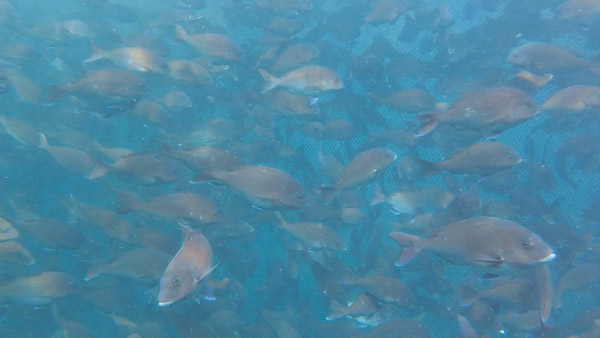Paper:
Body Measurement of Reared Red Sea Bream Using Stereo Vision
Kazuyoshi Komeyama*1, Tatsuya Tanaka*2, Takeharu Yamaguchi*3, Shigeru Asaumi*3, Shinsuke Torisawa*4, and Tsutomu Takagi*1
*1Faculty of Fisheries Sciences, Hokkaido University
3-1-1 Minato-cho, Hakodate 041-8611, Japan
*2Graduate School of Fisheries Sciences, Hokkaido University
3-1-1 Minato-cho, Hakodate 041-8611, Japan
*3FURUNO Electric Co., Ltd.
9-52 Ashihara-cho, Nishinomiya 662-8580, Japan
*4Department of Agriculture, Kindai University
3327-204 Nakamachi, Nara 631-0052, Japan
For aquaculture management, aquaculture farmers require a new, inexpensive device that can obtain the size of a fish without touching them, replacing the conventional spoon-net sampling method. Conventional sampling involves the risks of physical injury and mental stress to the fish, which may affect their growth rate and mortality. Therefore, we developed methods for monitoring the size of fish, considering red sea bream (RSB) aquaculture, using commercially available cameras. This study evaluates the sample size using the estimated mean fork length value in a cage, and its value is approximately 20 samples with a 2% error rate for a fork length of greater than 30 cm. We measured the fish fork length under water in the cage using both stereo vision and net-sampling methods simultaneously. The examination demonstrated that for RSB aquaculture, the estimated values of fork length from the two methods have no statistical difference. This result implies that our stereo vision system can be effectively applied to monitor RSB growth.

Reared Pagrus major in an aquaculture net-cage
- [1] “The State of World Fisheries and Aquaculture 2014,” Fisheries and Aquaculture Department, Food and Agriculture Organization of the United Nations, 2015.
- [2] T. Yamane, “Capture fisheries and aquaculture in Japan and the world: Current status and future concern, Marine Productivity: Perturbations and Resilience of Socio-ecosystems,” pp. 271-281, Springer, 2015.
- [3] E. Harvey, M. Cappo, M. Shortis, S. Robson, J. Buchanan, and P. Speare, “The accuracy and precision of underwater measurements of length and maximum body depth of southern bluefin tuna (Thunnus maccoyii) with a stereo-video camera system,” Fish. Res., Vol.63, pp. 315-326, 2003.
- [4] S. Torisawa, M. Kadota, K. Komeyama, K. Suzuki, and T. Takagi, “A digital stereo-video camera system for three-dimensional monitoring of free-swimming Pacific bluefin tuna, Thunnus orientalis, cultured in a net cage,” Aquat. Living Resour., Vol.24, pp. 107-112, 2011.
- [5] F. Shafait, E. Harvey, M. Shortis, A. Mian, M. Ravanbakhsh, J. Seager, P. Culverhouse, D. Cline, and D. Edgington, “Towards automating underwater measurement of fish length: a comparison of semi-automatic and manual stereo-video measurements,” ICES J. Mar. Sci., 2017.
- [6] K. Komeyama and S. Torisawa, “Introduction of ICT in reared fish management: development of monitoring technique for reared fish,” Nippon Suisan Gakkaishi, Vol.83, p. 94, 2017.
- [7] B. Jackson, D. Evangelista, D. Ray, and T. Hedrick, “3D for the people: multi-camera motion capture in the field with consumer-grade cameras and open source software,” Biol. Open, Vol.5, pp. 1334-1342, 2016.
- [8] K. Komeyama, S. Kunisawa, H. Hokazono, T. Kotani, A. Imamura, and T. Matsuoka, “Method to detect three-dimensional positions of juvenile Pacific bluefin tuna via image analysis,” Math. Physic. Fish. Sci., Vol.12, pp. 51-61, 2015 (in Japanese).
- [9] T. Hashimoto, S. Yamamoto, and A. Urashima, “LabVIEW image measurement Introduction,” Kodansha, 2011.
- [10] N. Hinrichs and S. McLean, “NLT and extrapolated DLT: 3-D cinematography alternatives for enlarging the volume of calibration,” J. of Biomech., Vol.28, pp. 1219-1223, 1995.
- [11] H. Takahashi, A. Matsuda, and T. Akamatsu, “Evaluation of the three-dimensional measurement accuracy of FISHCOM stereo camera system,” Technical Report of National Research Institute of Fisheries Engineering. Vol.28, pp. 87-93, 2006.
- [12] H. Takahashi, K. Sawada, Y. Takao, and K. Abe, “Inspection of the three-dimensional measurement accuracy of J-QUEST Stereo TV-camera system,” Technical Report of National Research Institute of Fisheries Engineering, Vol.17, pp. 81-92, 2005.
- [13] G. Wood and R. Marshal, “The accuracy of DLT extrapolation in three-dimensional film analysis,” J Biomech., Vol.19, pp. 781, 783-785, 1986.
- [14] N. Boutros, M. Shortis, and E. Harvey, “A comparison of calibration methods and system configurations of underwater stereo-video systems for applications in marine ecology,” Limnol. Oceanogr.: Methods, Vol.13, pp. 224-236, 2015.
- [15] S. Sagara, R. B. Ambar, and F. Takemura, “A stereo vision system for under water vehicle-manipulator systems – proposal of a novel concept using pan-tilt-slide cameras –,” J. of Robotics and Mechatronics, Vol.25, No.5, pp. 785-794, 2013.
 This article is published under a Creative Commons Attribution-NoDerivatives 4.0 Internationa License.
This article is published under a Creative Commons Attribution-NoDerivatives 4.0 Internationa License.